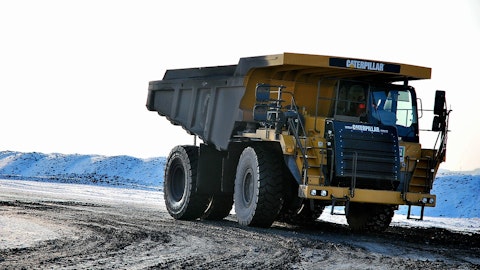Scott Wine: Steven, it really refers to, and again I’m not proud of the fact, just our inability to deliver in a timely manner. I mean, we’ve got the backlog, especially in our high horsepower tractors, that is quite long. And I think we’re just trying to get more confidence in our ability to deliver. We — again, inflation is — it’s not rising anymore, but it’s still out there. So, we also are making sure we manage our cost. You know, Derek and Stefano are really doing a nice job of managing cost inputs in their business, but it’s really that making sure we balance the cost-price equation, and you’ve seen from our history, we’re really good at doing that. But also, ensure that we can deliver when we say we’re going to deliver if we open up the books.
Steven Fisher: Okay, that’s fair. And then, I guess, in terms of the AG margins for 2023, can you maybe just give us any color on the puts and takes there? I imagine there were a number of inefficiencies in production, in 2022, due to the strike and the supply chain, and then you have Precision AG mix should be helpful, I would think, for 2023. So, can you talk about some of those puts and takes, and then what you’re expecting for price versus cost in 2023?
Oddone Incisa: Let me take this, Steve. Yes, you predicted — you pretty got it. I mean we expect 2023 to be a play of cost more than a play of pricing. We expect steel to be positive price over cost, as we have been throughout 2022. But the big game will be in getting cost out of the production system and reducing cost on to the production systems. And that’s a combination of having a smoother supply chain, and a more organized cadence, and possibly getting some improvement in — from our strategic sourcing program. That probably will kick in more at the end of the year rather than in the beginning of the year. But that’s what we’re looking at. And we have some carryover pricing for 2022 still coming in. And then you mentioned as well growing sales in tech, and which have generally higher margin than the pure equipment.
Steven Fisher: Okay, thank you.
Operator: Thank you. And our next question comes from David Raso from Evercore ISI. Please go ahead.
David Raso: Hi, thank you. I’m just trying to square up the implied volumes. When you look at the price — sorry, the revenue guide, of the 8%, I mean, currency shouldn’t be that much of a drag at these levels. So, and it looks like it’s mostly just price in the revenue guide. Is that the right way to interpret it, that basically volumes are flat? And if that is the case, if you can give us a little flavor where volumes up versus down just so we kind of square up any chance of overhead absorption?
Scott Wine: Volumes are up slightly, modestly — I don’t know, slightly modestly defined there, but it’s low single digits. North America is really where we see the greatest strength, and where we see the biggest backlog and where we’ve got the most work to do. So, I think that’ll be the volume play there, to a great extent. And the rest of — there’s still lots of work to do to deliver in other areas of the world, but that really will be where most of the volume comes from.
David Raso: And that’s more of an — large AG comment, and I know the units are bigger —
Scott Wine: No, you go it. It’s high horsepower tractors and combines, and in that order.
David Raso: And Oddone, the comment about steel — more about steel than price, and so I understood what you were implying there, do we still think our steel costs are up year-over-year more than price? And it’s all wrapped in a thought around do we think gross margins can expand in ’23? I just want to make sure I understand that margin comment.





